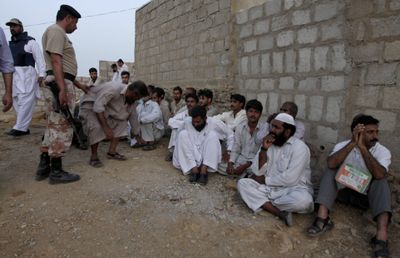Taliban finding safety in Karachi
Stability a concern in Pakistan city

KARACHI, Pakistan – Taliban fighters seeking money, rest and refuge from U.S. missile strikes are turning up in increasing numbers in Pakistan’s largest city and economic hub, Karachi, according to militants, police officials and an intelligence memo.
The Taliban presence in this southern port city, hundreds of miles from the Islamist extremists’ strongholds in the northwest, shows how quickly their influence is spreading throughout the nuclear-armed nation.
Karachi is especially important because it is the main entryway for supplies headed to U.S. and NATO forces in Afghanistan, as well as the city most critical to Pakistani commerce. Few believe the Taliban could actually take over this diverse metropolis of more than 16 million, but there is fear that they could destabilize it through violence and rock the already shaky national economy.
As the Pakistan military intensifies its attacks in the northwest and the U.S. keeps launching missiles there, more insurgents are seeking safety in Karachi and other urban areas, militants said.
“We come in different batches to Karachi to rest and if needed, get medical treatment, and stay with many of our brothers who are living here in large numbers,” 32-year-old militant Omar Gul Mehsud told the Associated Press while strolling along the beach, astonished at the vastness of the sea, which he’d never seen before.
Shah Jahan, a 35-year-old who said he commands about 24 Taliban fighters in the South Waziristan tribal region, told the AP that militants are scattering throughout Pakistan to avoid the U.S. missile strikes. He said groups of 20 to 25 fighters would fight for a few months, then take leaves of up to one month in cities including Karachi.
“We are more alert and cautious following the drone attacks, and we understand that it is not a wise approach to concentrate in a large number in the war-torn areas,” he said.
On the outskirts of Karachi, large settlements of Afghan and Pakistani refugees have swelled over the past year by as many as 200,000 people. These refugees are mostly Pashtun, the ethnic group that dominates the militancy. An intelligence report obtained by the AP warns that such neighborhoods have become favored hideouts for militants linked to Baitullah Mehsud, Pakistan’s top Taliban commander.
The report from the police’s Special Branch says Mehsud-linked militants are arriving in batches of 20 to 25 every 30 to 35 days “for rest as well as for generating funds.” It adds that the militants make money “through criminal activities like kidnapping for ransom, bank robbery, street robbery and other heinous crimes.”
The various settlements – dilapidated, poor, crime-ridden and wary of outsiders – sit along major entry and exit points to the city from east to west.
“That’s a very alarming formation,” a senior official at the Intelligence Bureau, another spy agency, told AP on condition of anonymity because he was not authorized to speak on the record.
The Sohrab Goth neighborhood, for instance, is next to Super Highway, a major thoroughfare for materials heading to Afghan-based U.S. and NATO forces. Past ethnic violence in the area, including as recently as December, has led to shutdowns of the highway.
Senior police officer Raja Omar Khatab told AP that investigations showed earth-excavation companies owned by members of the Mehsud tribe were helping fund the Taliban.
“Forcibly or voluntarily, they are bound to pay 40 percent of their earnings to Baitullah because they belong to that tribe and they are concerned about their survival and their links to their tribe,” said Khatab, who has twice been a target of militant attacks.
A.D. Khowaja, another senior police official, said up to a third of Karachi bank robberies in the past two or three years were believed to help fund militant groups including the Taliban. Police statistics show in 2008, 29 robberies of banks or their cash-carrying vehicles were reported in Karachi, with losses of nearly a million dollars.
In general, analysts, political leaders and security officials agree the Taliban has a network in Karachi, but differ on the number of militants and the immediacy of the threat.
Khowaja estimated hundreds of Taliban fighters were in the city. Leaders of the city’s main party, the Muttahida Qaumi Movement, say the local Taliban presence is in the thousands, and warn that the militants could find support among the countless students who attend Karachi’s 3,000 Islamic schools.
Rivals accuse the MQM of exaggerating the threat of the Taliban because of its history of bias against Pashtuns, an estimated 2 to 4 million of whom live in Karachi.
A Taliban fighter from South Waziristan, Samiullah Wazir, said the Taliban had no imminent plans to stage attacks in Karachi. While the AP has no way of verifying the names or claims of militants, their descriptions and accounts generally matched and were in line with police and intelligence reports.
For Karachi residents, all the talk of the Taliban has brought confusion and nervousness. Some said they thought twice about what they wore or where they went, but that they still felt generally safe.